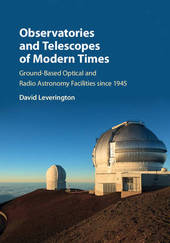
|
Observatories and Telescopes of Modern Times: Ground-Based Optical and Radio Astronomy Facilities since 1945
Hardback
Main Details
| Title |
Observatories and Telescopes of Modern Times: Ground-Based Optical and Radio Astronomy Facilities since 1945
|
| Authors and Contributors |
By (author) David Leverington
|
| Physical Properties |
| Format:Hardback | | Pages:501 | | Dimensions(mm): Height 253,Width 178 |
|
| Category/Genre | History of science
Observatories, equipment and methods
Engineering - general |
|---|
| ISBN/Barcode |
9780521899932
|
| Classifications | Dewey:522.109045 |
|---|
| Audience | | Professional & Vocational | |
|---|
| Illustrations |
11 Tables, black and white; 91 Halftones, black and white
|
|
Publishing Details |
| Publisher |
Cambridge University Press
|
| Imprint |
Cambridge University Press
|
| Publication Date |
24 November 2016 |
| Publication Country |
United Kingdom
|
Description
This volume gives an historical overview of the development of professional optical and radio observatories from 1945 to today. It covers the environment in which these facilities were developed by organisations in the United States, Europe and elsewhere, often led by larger-than-life individuals, as well as exploring the financial and political factors that both constrained and encouraged progress. As ever more expensive optical facilities were built, they exploited new technologies to significantly improve their performance: CCDs, active and adaptive optics, and spun honeycomb and segmented mirrors. The second half of this volume turns to the parallel history of radio astronomy facilities throughout the world, finishing with the ALMA observatory in Chile. This is the ground-based companion to the author's previous work on space astronomy, New Cosmic Horizons (2001). It is written for both technical and non-technical readers interested in the modern history of astronomy and its observational facilities.
Author Biography
David Leverington received his degree in Physics from the University of Oxford in 1963. Since then he has held a number of senior positions in the space industry, working for both the European Space Agency and British Aerospace before taking early retirement in 1992. Subsequently he has written four books: A History of Astronomy from 1890 to the Present (1996), New Cosmic Horizons: Space Astronomy from the V2 to the Hubble Space Telescope (Cambridge, 2001), Babylon to Voyager and Beyond: A History of Planetary Astronomy (Cambridge, 2003) and the Encyclopedia of the History of Astronomy and Astrophysics (Cambridge, 2013). He was also technical consultant for ABC-CLIO's Space Exploration and Humanity: A Historical Encyclopedia (2010), supported by the History Committee of the American Astronautical Society.
Reviews'I recommend this book as an incredibly detailed historical record of the design, construction and operation of the world's ground-based optical and radio astronomy facilities; their spatial and temporal distribution covers all continents from 1945 to the present ... this book is a testament to the wonders of the universe as detected by optical and radio telescopes.' Barry R. Masters, Optics and Photonics News 'I found this book an exceptionally important contribution to the history of observational astronomy in the second half of the 20th century ... On offer here is a masterly overview of the development of ground-based optical and radio astronomy since 1945 ... a splendid guide to the professional observatories of the modern age, with an emphasis on covering innovation in the broadest sense...It is an essential purchase for libraries.' Simon Mitton, The Observatory: A Review of Astronomy 'David Leverington tells a concise history about those many astronomical structures. That is a lot of observatories and telescopes, and he admits that it may 'read a little more like an encyclopedia'. An encyclopedic tour it is ... The author's decision to organize his book around telescopes rather than scientific achievements allows each chapter to be read independently ... Leverington traces the developments at different locations and puts together a cohesive narrative ... he delves into the role of individual astronomers ... strikes a good balance by imparting sufficient information without going into too much detail ... Observatories and Telescopes of Modern Times offers technically informed readers an excellent reference. Readers will come away from the book with a better understanding of existing telescopes and observatories along with some of their scientific specifications and achievements.' Eun-Joo Ahn, Physics Today 'The lengthy and detailed descriptions are useful and interesting, the tables are of considerable reference value, and the illustrations are excellent. The points about the advantages for optical instruments of the remoteness of Hawaii, the Canary Islands, Chile, etc. (no light pollution) and altitude (Mauna Kea is probably the highest place on land that can be visited routinely) are well made.' Ray Ward, Reference Reviews 'While other books have focused on a survey of telescopes and observatories in various eras of astronomy, this is the first to comprehensively tackle the complex task of the post-1945 era. ... For each observatory, beginning with the 200-in Palomar Telescope, the author carefully explains the scientific and political considerations that led to their construction. It would have been easy to give the human dimension short shrift, but by examining often contentious conversations and negotiations, Leverington offers us a superb capsule history of each observatory. ... The book is profusely illustrated (all in black and white) so that each telescope or observatory has at least one photo or artist conception. ... David Leverington has written the definitive account of modern observatories that is not only readable but a valuable sourcebook for the telescopic era of the past 70 years.' Clifford J. Cunningham, Journal of Astronomical History and Heritage 'The author is to be congratulated for the meticulous research he has carried out toproduce a book which will be of great interest to optical and radio astronomers. He has produced an astronomical encyclopedia which readers who wish to pursue thehistorical development of observatories and innovative telescopes will find of greatinterest.' Ragbir Bhathal, Metascience
|